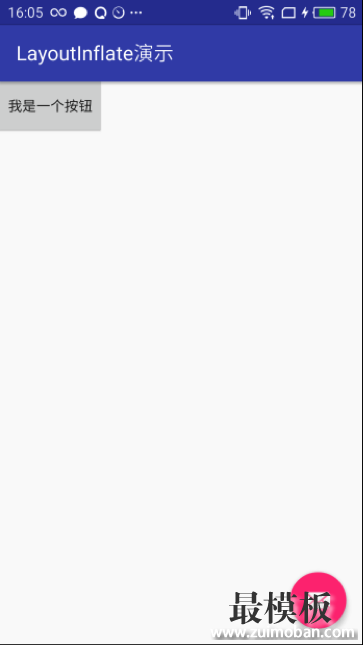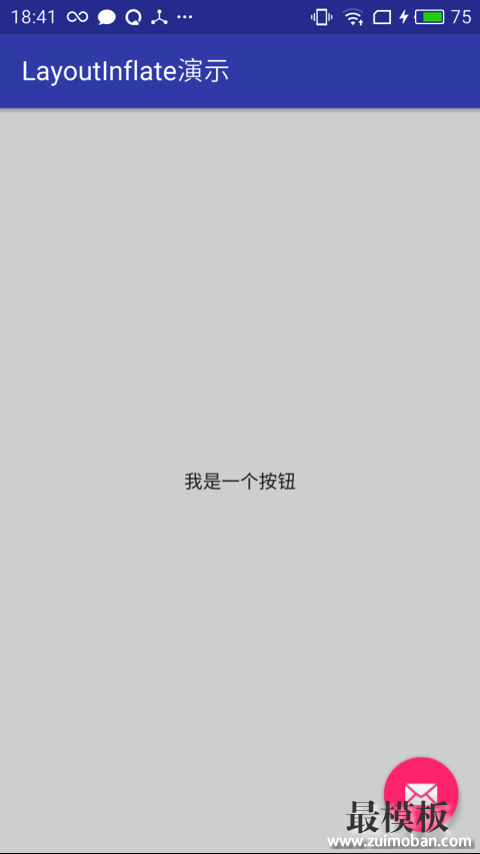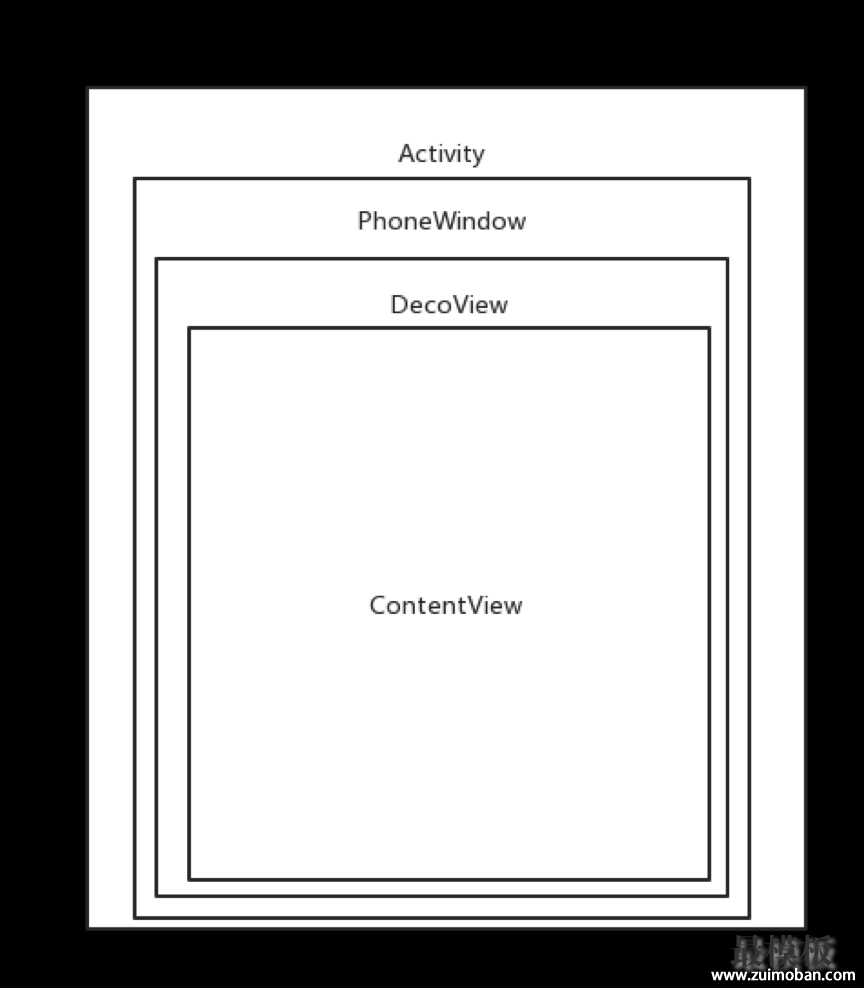关于LayoutInflater的使用,在开发的过程中,LayoutInfalter经常用于加载视图,对,今天咱们来聊的就是,关于加载视图的一些事儿,我记得之前一位曾共事过的一位同事问到我一个问题,activity是如何加载资源文件来显示界面的,古话说得好,知其然不知其所以然,因此在写这篇文章的时候我也做了不少的准备,在这里我先引出几个问题,然后我们通过问题在源码中寻找答案。 1.如何获取LayoutInflater? 2.如何使用LayoutInflater?为什么? 3.Activity是如何加载视图的? 4.如何优化我们的布局? 首先我们先看一下LayoutInflater是如何获取的。 LayoutInflater inflater=LayoutInflater.from(context); 我们通过LayoutInflater.from(Context)获取LayoutInflater,我们继续进入LayoutInflater.java探索一番。 LayoutInflater.java:
/**
* Obtains the LayoutInflater from the given context.
*/
public static LayoutInflater from(Context context) {
LayoutInflater LayoutInflater =
(LayoutInflater) context.getSystemService(Context.LAYOUT_INFLATER_SERVICE);
if (LayoutInflater == null) {
throw new AssertionError("LayoutInflater not found.");
}
return LayoutInflater;
}
在LayoutInflater里面,通过静态方法from(Context),然后继续调用Context中的方法getSystemService获取LayoutInflater,我们往Context继续看。 Context.java: public abstract Object getSystemService(@ServiceName @NonNull String name); 大家会发现,怎么点进去这是个抽象方法,其实Context是一个抽象类,真正实现的是ContextImpl这个类,我们就继续看ContextImpl: ContextImpl.java:
@Override
public Object getSystemService(String name) {
//继续调用SystemServiceRegistry.getSystemService
return SystemServiceRegistry.getSystemService(this, name);
}
SystemServiceRegistry.java:
/**
* Gets a system service from a given context.
*/
public static Object getSystemService(ContextImpl ctx, String name) {
//先获取ServiceFetcher,在通过fetcher获取LayoutInflate
ServiceFetcher<?> fetcher = SYSTEM_SERVICE_FETCHERS.get(name);
return fetcher != null ? fetcher.getService(ctx) : null;
}
SystemServiceRegistry这个类中的静态方法getSystemService,通过SYSTEM_SERVICE_FETCHERS获取ServiceFetcher,我们先看看SYSTEM_SERVICE_FETCHERS跟ServiceFetcher在SystemServiceRegistry中的定义。 SystemServiceRegistry.java:
//使用键值对来保存
private static final HashMap<String, ServiceFetcher<?>> SYSTEM_SERVICE_FETCHERS =
new HashMap<String, ServiceFetcher<?>>();
/**
* Base interface for classes that fetch services.
* These objects must only be created during static initialization.
*/
static abstract interface ServiceFetcher<T> {
//只有一条接口,通过context获取服务,先看一下其实现类
T getService(ContextImpl ctx);
}
SYSTEM_SERVICE_FETCHERS在SystemServiceRegistry这个类中作为全局常量,通过键值对的方式用来保存ServiceFetcher,而ServiceFetcher又是什么?在源码中,ServiceFetcher是一条接口,通过泛型T定义了getService(ContextImpl)来获取服务对象。那么具体ServiceFetcher具体的实现在什么地方?在SystemServiceRegistry中,有一段这样的代码: SystemServiceRegistry.java:
static {
.....
registerService(Context.LAYOUT_INFLATER_SERVICE, LayoutInflater.class,
new CachedServiceFetcher<LayoutInflater>() {
@Override
public LayoutInflater createService(ContextImpl ctx) {
return new PhoneLayoutInflater(ctx.getOuterContext());
}});
......
}
在这个静态代码块中,通过registerService进行初始化注册服务。我们先看看这个静态方法。
/**
* Statically registers a system service with the context.
* This method must be called during static initialization only.
*/
private static <T> void registerService(String serviceName, Class<T> serviceClass,
ServiceFetcher<T> serviceFetcher) {
SYSTEM_SERVICE_NAMES.put(serviceClass, serviceName);
SYSTEM_SERVICE_FETCHERS.put(serviceName, serviceFetcher);
}
registerService这个一段函数的作用就是用来通过键值对的方式,保存服务对象,也就是说,SystemServiceRegistry会初始化的时候注册各种服务,而我们的也看到Context.LAYOUT_INFLATER_SERVICE作为key来获取LayoutInfalter。 Context.java:
/**
* 定义这个常量,用于获取系统服务中的LayoutInflate
* Use with {@link #getSystemService} to retrieve a
* {@link android.view.LayoutInflater} for inflating layout resources in this
* context.
*
* @see #getSystemService
* @see android.view.LayoutInflater
*/
public static final String LAYOUT_INFLATER_SERVICE = "layout_inflater";
我们继续看看ServiceFetcher的实现类:
/**
* Override this class when the system service constructor needs a
* ContextImpl and should be cached and retained by that context.
*/
static abstract class CachedServiceFetcher<T> implements ServiceFetcher<T> {
private final int mCacheIndex;
public CachedServiceFetcher() {
mCacheIndex = sServiceCacheSize++;
}
@Override
@SuppressWarnings("unchecked")
public final T getService(ContextImpl ctx) {
final Object[] cache = ctx.mServiceCache;
synchronized (cache) {
// Fetch or create the service.
Object service = cache[mCacheIndex];
if (service == null) {
service = createService(ctx);
cache[mCacheIndex] = service;
}
return (T)service;
}
}
public abstract T createService(ContextImpl ctx);
}
CachedServiceFetcher的作用用于保存我们的泛型T,同时这个CachedServiceFetcher有一个抽象方法createService,createService这个方法用来创建这个服务,因此使用这个类就必须重写这个方法,我们继续看回: ServiceFetcher.java:
staic{
registerService(Context.LAYOUT_INFLATER_SERVICE, LayoutInflater.class,
new CachedServiceFetcher<LayoutInflater>() {
@Override
public LayoutInflater createService(ContextImpl ctx) {
return new PhoneLayoutInflater(ctx.getOuterContext());
}});
}
现在看回来这里,注册服务不就是通过通过键值对的方式进行保存这个对象,然而我们获取到的LayoutInflater其实是PhoneLayoutInflater。PhoneLayoutInflater继承于LayoutInfalter. 小结: 我们获取LayoutInflater对象,可以通过两种方法获取: LayoutInflater inflater1=LayoutInflater.from(context); LayoutInflater inflater2= (LayoutInflater) context.getSystemService(Context.LAYOUT_INFLATER_SERVICE); context的实现类contextImpl,调用SystemServiceRegistry.getSystemService,通过键值对的方式获取PhoneLayoutInflater对象,从中我们也看到,这种方式通过键值对的方式缓存起这个对象,避免创建过多的对象,这是也一种单例的设计模式。 现在咱们来看一下,我们是如何使用LayoutInflater来获取View,我们先从一段小代码看看。 我新建一个布局文件,my_btn.xml:
<?xml version="1.0" encoding="utf-8"?>
<Button xmlns:android="http://schemas.android.com/apk/res/android"
android:layout_width="match_parent"
android:layout_height="match_parent"
android:orientation="vertical"
android:text="我是一个按钮">
</Button>
在布局文件中,我设置其layoutwidth与layout_height分别是填充屏幕。 在activity的content_main.xml布局:
<?xml version="1.0" encoding="utf-8"?>
<RelativeLayout xmlns:android="http://schemas.android.com/apk/res/android"
xmlns:app="http://schemas.android.com/apk/res-auto"
xmlns:tools="http://schemas.android.com/tools"
android:id="@+id/content_main"
android:layout_width="match_parent"
android:layout_height="match_parent"
app:layout_behavior="@string/appbar_scrolling_view_behavior"
tools:context="ffzxcom.mytest.toucheventapplication.MainActivity"
tools:showIn="@layout/activity_main">
</RelativeLayout>
LayoutInflater.java: 方法一:
public View inflate(@LayoutRes int resource, @Nullable ViewGroup root) {
return inflate(resource, root, root != null);
}
方法二:
public View inflate(@LayoutRes int resource, @Nullable ViewGroup root, boolean attachToRoot) {
final Resources res = getContext().getResources();
if (DEBUG) {
Log.d(TAG, "INFLATING from resource: \"" + res.getResourceName(resource) + "\" ("
+ Integer.toHexString(resource) + ")");
}
//通过资源加载器和资源Id,获取xml解析器
final XmlResourceParser parser = res.getLayout(resource);
try {
return inflate(parser, root, attachToRoot);
} finally {
parser.close();
}
}
我们从代码中看到,无论是方法一,还是方法二,最终还是会调用方法二进行加载,我们就从方法二的三个参数,进行分析一下。 @LayoutRes int resource 资源文件的Id @Nullable ViewGroup root 根view,就是待加载view的父布局 boolean attachToRoot 是否加载到父布局中 从方法一看到,其实就是在调用方法二,只是方法一的第三个传参利用root!=null进行判断而已,实际上最终还是调用方法二。 我们先利用代码进行分析一下:
@Override
protected void onCreate(Bundle savedInstanceState) {
super.onCreate(savedInstanceState);
setContentView(R.layout.activity_main);
Toolbar toolbar = (Toolbar) findViewById(R.id.toolbar);
setSupportActionBar(toolbar);
mContainer = (RelativeLayout) findViewById(R.id.content_main);
View view1 = LayoutInflater.from(this).inflate(R.layout.my_btn, null);
View view2 = LayoutInflater.from(this).inflate(R.layout.my_btn, mContainer, false);
View view3 = LayoutInflater.from(this).inflate(R.layout.my_btn, mContainer, true);
View view4 = LayoutInflater.from(this).inflate(R.layout.my_btn, mContainer);
Log.e("view1:", view1 + "");
Log.e("view2:", view2 + "");
Log.e("view3:", view3 + "");
Log.e("view4:", view4 + "");
}
我们加载同一个布局文件my_btn.xml,获取到view,然后分别输出,观察有什么不一样:
view1:: android.support.v7.widget.AppCompatButton{27f4a822 VFED..C. ......I. 0,0-0,0}
view2:: android.support.v7.widget.AppCompatButton{14fb5dd2 VFED..C. ......I. 0,0-0,0}
view3:: android.widget.RelativeLayout{2a6bba10 V.E..... ......I. 0,0-0,0 #7f0c006f app:id/content_main}
view4:: android.widget.RelativeLayout{2a6bba10 V.E..... ......I. 0,0-0,0 #7f0c006f app:id/content_main}
问题来了,为什么我加载同一个布局,得到的view一个是Button,一个是RelativeLayout,我们每一个分析一下: View1: LayoutInflater.from(this).inflate(R.layout.my_btn, null); 我们看到,第二个参数root为空,也就是说实际上是调用方法二(root!=null): LayoutInflater.from(this).inflate(R.layout.my_btn, null,false); 第三个参数attachToRoot 的意思是,是否把这个view添加到root里面,如果为false则不返回root,而是这个的本身,如果为true的话,就是返回添加view后的root. 因此,view1得到的是Button. View2: LayoutInflater.from(this).inflate(R.layout.my_btn, mContainer, false); 同上可得,第三个参数attachToRoot 为false.也就是不把这个view添加到root里面去 因此,返回的是view2,就是Button. View3: LayoutInflater.from(this).inflate(R.layout.my_btn, mContainer, true); 第三个参数为true,也就是意味待加载的view会附在root上,并且返回root. 因此,我们view3返回的是这个RelativeLayout,并且是添加button后的RelativeLayout. View4: LayoutInflater.from(this).inflate(R.layout.my_btn, mContainer); 根据方法一跟方法二的比较,root!=null.view4跟view3的加载是一样的,同理返回的是RelativeLayout. 根据以上的结论我们继续往下面探究,我们通过LayoutInflater.from(this).inflate(R.layout.my_btn, null)获取到了button,再把这个Button添加到mContainer中。再观察一下效果,注意,这个按钮的布局宽高是占全屏的。
<?xml version="1.0" encoding="utf-8"?>
<Button xmlns:android="http://schemas.android.com/apk/res/android"
android:layout_width="match_parent"
android:layout_height="match_parent"
android:orientation="vertical"
android:text="我是一个按钮">
</Button>
@Override
protected void onCreate(Bundle savedInstanceState) {
super.onCreate(savedInstanceState);
setContentView(R.layout.activity_main);
Toolbar toolbar = (Toolbar) findViewById(R.id.toolbar);
setSupportActionBar(toolbar);
mContainer = (RelativeLayout) findViewById(R.id.content_main);
Button btn = (Button) LayoutInflater.from(this).inflate(R.layout.my_btn, null);
mContainer.addView(btn);
}

无标题.png 大家看到问题了吗?为什么我在my_btn.xml中设置了button的布局宽高是全屏,怎么不起作用了?难道说在my_btn.xml中Button的layout_width和layout_height起不了作用?我们从源码中看一下:
public View inflate(@LayoutRes int resource, @Nullable ViewGroup root, boolean attachToRoot) {
//获取资源加载器
final Resources res = getContext().getResources();
if (DEBUG) {
Log.d(TAG, "INFLATING from resource: \"" + res.getResourceName(resource) + "\" ("
+ Integer.toHexString(resource) + ")");
}
//通过资源加载器和资源Id,获取xml解析器
final XmlResourceParser parser = res.getLayout(resource);
try {
return inflate(parser, root, attachToRoot);
} finally {
parser.close();
}
}
通过资源管理获取xml解析器,继续往下看:
public View inflate(XmlPullParser parser, @Nullable ViewGroup root, boolean attachToRoot) {
synchronized (mConstructorArgs) {
......
//保存传进来的这个view
View result = root;
try {
// Look for the root node.
int type;
//在这里找到root标签
while ((type = parser.next()) != XmlPullParser.START_TAG &&
type != XmlPullParser.END_DOCUMENT) {
// Empty
}
if (type != XmlPullParser.START_TAG) {
throw new InflateException(parser.getPositionDescription()
+ ": No start tag found!");
}
//获取这个root标签的名字
final String name = parser.getName();
......
//判断是否merge标签
if (TAG_MERGE.equals(name)) {
if (root == null || !attachToRoot) {
throw new InflateException("<merge /> can be used only with a valid "
+ "ViewGroup root and attachToRoot=true");
}
//这里直接加载页面,忽略merge标签,直接传root进rInflate进行加载子view
rInflate(parser, root, inflaterContext, attrs, false);
} else {
//通过标签来获取view
//先获取加载资源文件中的根view
final View temp = createViewFromTag(root, name, inflaterContext, attrs);
//布局参数
ViewGroup.LayoutParams params = null;
//关键代码A
if (root != null) {
params = root.generateLayoutParams(attrs);
if (!attachToRoot) {
//temp设置布局参数
temp.setLayoutParams(params);
}
}
......
//关键代码B
//在这里,先获取到了temp,再把temp当做root传进去rInflateChildren
//进行加载temp后面的子view
rInflateChildren(parser, temp, attrs, true);
......
//关键代码C
if (root != null && attachToRoot) {
//把view添加到root中并设置布局参数
root.addView(temp, params);
}
//关键代码D
if (root == null || !attachToRoot) {
result = temp;
}
}
} catch (XmlPullParserException e) {
......
} catch (Exception e) {
......
} finally {
......
}
return result;
}
}
在这一块代码中,先声明一个变量result,这个result用来返回最终的结果,在我们的演示中,如果inflate(resource,root,isAttachRoot)中的root为空,那么布局参数params为空,并且根据关键代码D可得,返回的result就是temp,也就是Button本身。因此在以上例子中,如果说root不为空的话,Button中声明的layout_width与layout_height起到了作用。
@Override
protected void onCreate(Bundle savedInstanceState) {
super.onCreate(savedInstanceState);
setContentView(R.layout.activity_main);
Toolbar toolbar = (Toolbar) findViewById(R.id.toolbar);
setSupportActionBar(toolbar);
mContainer = (RelativeLayout) findViewById(R.id.content_main);
View view1 = LayoutInflater.from(this).inflate(R.layout.my_btn, mContainer,false);
mContainer.addView(view1);
}

无标题.png 注:如果通过LayoutInflater.from(this).inflate(R.layout.my_btn, mContainer)或者LayoutInflater.from(this).inflate(R.layout.my_btn, mContainer,true)加载视图,不需要再额外的使用mContainer.addView(view),因为返回的默认就是root本身,在关键代码C中可看到:
if (root != null && attachToRoot) {
root.addView(temp, params);
}
root会添加temp进去,在代码初始化的时候,result默认就是root,我们不需要addView,在inflate中会帮我们操作,如果我们还要addView的话,就会抛出异常: The specified child already has a parent. You must call removeView() on the child's parent first. 小结: 如果LayoutInflater的inflate中,传参root为空时,加载视图的根view布局宽高无效。反之根据关键代码C与关键代码A,分别对view进行设置布局参数。 咱们来看一下activity是如何加载视图,我们从这一段代码开始:
public class MainActivity extends AppCompatActivity {
@Override
protected void onCreate(Bundle savedInstanceState) {
super.onCreate(savedInstanceState);
setContentView(R.layout.activity_main);
}
}
我们往setContentView继续探索,找到Activity的setContentView()
/**
* Set the activity content from a layout resource. The resource will be
* inflated, adding all top-level views to the activity.
*
* @param layoutResID Resource ID to be inflated.
*
* @see #setContentView(android.view.View)
* @see #setContentView(android.view.View, android.view.ViewGroup.LayoutParams)
*/
public void setContentView(@LayoutRes int layoutResID) {
//获取窗口,设置contentView
getWindow().setContentView(layoutResID);
initWindowDecorActionBar();
}
getWindow()实际上是获取window对象,但Window类是抽象类,具体的实现是PhoneWindow,我们往这个类看看: PhoneWindow.java:
@Override
public void setContentView(int layoutResID) {
//判断mContentParent是否为空,如果为空,创建
if (mContentParent == null) {
installDecor();
} else if (!hasFeature(FEATURE_CONTENT_TRANSITIONS)) {
// 清空mContentParent 所有子view
mContentParent.removeAllViews();
}
if (hasFeature(FEATURE_CONTENT_TRANSITIONS)) {
……
} else {
//通过layoutInflate加载视图
mLayoutInflater.inflate(layoutResID, mContentParent);
}
……
}
activity加载视图,最后还是通过LayoutInflater进行加载视图,activity的界面结构如下: 
无标题.png 我们的mContentView就是ContentView,因此通过LayoutInflater加载视图进入ContentView。而root就是mContentView,因此我们在Activity不需要自己addView(). 总结: 知其然不知其所以然,这对于LayoutInflater描述再合适不过了,文章中本来还涉及到了关于如何使用LayoutInflater中遍历view,代码太长就不一一展示,而且在inflate中我们可以看到,通过使用merge标签,可以减少view的层级,直接把merge标签内的子view直接添加到rootview中,因此布局优化能提高视图加载的性能,提高效率。还有获取LayoutInflater的方式,通过键值对进行缓存LayoutInflater,这是在android中单例设计的一种体验。 (责任编辑:好模板) |
探索Android视图加载器LayoutInflater
时间:2016-11-05 09:49来源:未知 作者:好模板 点击:次
关于LayoutInflater的使用,在开发的过程中,LayoutInfalter经常用于加载视图,对,今天咱们来聊的就是,关于加载视图的一些事儿,我记得之前一位曾共事过的一位同事问到我一个问题,
顶一下
(0)
0%
踩一下
(0)
0%
------分隔线----------------------------
- 上一篇:Android 中的消息机制
- 下一篇:Android自定义View实战之角度选择器
- 热点内容

-
- Android为什么选择了Java
2007年Android刚刚出生的时候, 看到开发语言是Java, 我很高兴,...
- Android中输出HTML格式下的文字
在Android中,我们经常会用到TextView这个控件,在使用的过程中,...
- Android 欢迎页快速启动
默认情况下,Android App在点击App logo到App完全启动这之间会有一段...
- android动画详解六 XML中定义动画
属性动画系统允许动画View对象并提供很多比view动画系统更高级...
- Sensor和SensorManager实现重力和方向
一.Android中检测重力感应变化大致需要下面几个步骤: 1.得到传...
- Android为什么选择了Java
- 随机模板
-
-
 蓝色中英繁三语全静态S
人气:343
蓝色中英繁三语全静态S
人气:343
-
 Prestashop多用途英文服饰商
人气:154
Prestashop多用途英文服饰商
人气:154
-
 织梦dedecms化妆品商贸公司
人气:1009
织梦dedecms化妆品商贸公司
人气:1009
-
 ecshop也买酒2012最新模板
人气:2991
ecshop也买酒2012最新模板
人气:2991
-
 织梦dedecms金融投资管理公
人气:2199
织梦dedecms金融投资管理公
人气:2199
-
 zencart鞋类模板
人气:2895
zencart鞋类模板
人气:2895
-
